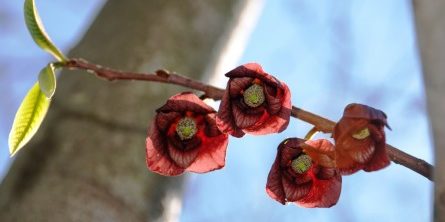THE LEAFLET

Tree of the Month: Pawpaw
The tale of the Pawpaw is that of a lost treasure rediscovered. It is the United States’ largest native edible fruit and was once highly valued by Native Americans. European settlers too were enamored with the Pawpaw, but somewhere around the turn of the 1900’s, a rapidly urbanizing American public had all but forgotten this fruit. However, the past few decades have seen a concerted effort to realize the Pawpaw’s agricultural and horticultural potential. A native, large, delicious fruit with very few pests that can even fruit in the shade: who wouldn’t at least give it a try? So where city folk would look at you funny if you said the word ‘Pawpaws’ a decade ago, many in Washington, D.C. have recently been bucking the trend. Foodies and native plant people have given this tree a go in their yards across the city. And many school garden coordinators have found this low maintenance tree a perfect candidate for getting food into the physical and educational landscape of their schools.
It seems the one drawn back of the Pawpaw as a food crop is its short shelf life. But this almost increases the appeal because when you scoop into a fresh one, you can be sure it was grown somewhere nearby (possibly in your neighbor’s yard). As plant breeders bring forth the best varieties and as growers develop the best techniques for cultivation in garden and farm settings, the Pawpaw is sure to continue its march towards renewed public appreciation and to contribute to a more elegant food system here. And what does it taste like you ask? Banana custard, mango, pear, papaya…it really can’t be described. Find a kind neighbor or snoop around at a farmer’s market to find out for yourself.

For the botanists and tree geeks out there, the Pawpaw offers more than just a delicious fruit to whet our appetite with. It is truly a botanical anomaly. The family of plants Pawpaw resides in, Annonaceae, is distinctly tropical and our tree is the only species native to temperate North America. The Pawpaw holds the somewhat rare characteristic of having its flowers pollinated by beetles and flies (I’ve seen ants hanging out in pawpaw flowers, as well as spiders waiting to prey on unsuspecting insects). But the funny thing is the flowers are not very good at getting themselves pollinated. It could be that the insects that evolved to do the work effectively have gone extinct, or some other strange shift in evolution or ecology has resulted in the flowers not producing enough of a scent to effectively attract the right pollinators. Or perhaps the pawpaw just doesn’t intend to have all its flowers pollinated for some reason. The other ecological problem for Pawpaw is that of seed dispersal. Few animals that eat pawpaw can actually fully ingest the large seed, which is necessary for the animal to then excrete it elsewhere later.
The theory is that the larger animals that were the principle dispersers of the pawpaw have gone extinct. The same theory goes on to suggest that it is likely that not forest animals, but instead humans have probably been the primary dispersers of Pawpaw seeds. This makes sense considering that Native Americans valued the Pawpaw fruit and were likely to have dispersed the seed to different lands as they moved from place to place. To make up for poor seed dispersal, the Pawpaw readily sends up root suckers such that one root system will support lots of trees, forming a clonal grove. And finally, the Pawpaw leaves, seeds and twigs hold some interesting compounds that could be used as anti-cancer agents and insecticides (as well as toxicity to humans. Only eat the ripe fruit!) How’s that for a tree with character.
From food security and culinary delight to pharmaceutical and botanical interest, the Pawpaw is certainly an engaging tree. And with all that it maxes out at 25 feet in full sun and could fit in many yards and landscapes across the city. Stop by the National Arboretum’s Washington Youth Garden or the Casey Trees office to see this tree in action and decide if it could be right for your yard (and your dinner table).